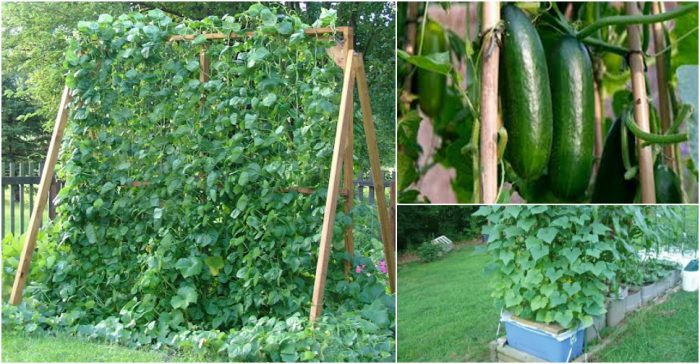Cucumbers are a tasty vegetable that also happen to be prolific growers. The sprawling vines can easily take over your garden if left to spread along the ground. Growing cucumbers vertically saves space while promoting better airflow and sun exposure for improved plant health and abundant harvests.
Overview on Vertical Cucumber Growing
Cucumbers are warm season vegetables that thrive in full sun The long trailing vines of vining varieties are perfect for training up vertical supports This allows the vigorous plants to make better use of the available space instead of monopolizing precious square footage in your veggie plot.
Vertical cucumber gardening opens things up and improves air circulation around the foliage. Better airflow means lower humidity at plant level, reducing the risk of fungal diseases, mildews and rot. Suspending the vines off the ground also limits slug and snail damage. Meanwhile, both sides of the leaves can capture sunlight for photosynthesis when grown upwards, boosting plant vigor and productivity.
So how do you actually grow cucumbers to climb high instead of sprawl wide? Let’s go over some key techniques for successful vertical cucumber gardening.
Choose Appropriate Cucumber Varieties
To grow cucumbers vertically, select vining types with long trailing stems. Some top options include:
- Armenian cucumbers
- Burpless/Boston pickling cucumbers
- English/hothouse cucumbers
- Lemon cucumbers
- Marketmore cucumbers
- Straight eight cucumbers
- Suyo long cucumbers
Avoid bush type cucumbers that have short, compact growth habits. These are best suited to container gardening or smaller spaces where their naturally restricted size limits their spread
Provide Strong Vertical Supports
Climbing cucumbers need sturdy upright structures to clamber up. Some options for vertical supports include:
- Trellises – Classic option made from wood, metal, bamboo or plastic
- Cattle panels – Heavy duty welded wire fencing is perfect for vigorous climbers
- Teepees – Made from long bamboo poles or wooden stakes
- Pergolas & arbors – Great permanent vertical structures for yard or edges
- Fencing – Attach trellising to existing walls or fences
- Strings – Tie strings between sturdy upright posts
Aim for vertical supports at least 5-6 feet tall. Position supports before planting cucumbers at their bases. Take wind exposure into account and install supports firmly.
Guide Vines Up Supports
Cucumbers may need a little help starting their vertical climb. As vines lengthen, gently twist them around supports, securing with soft plant ties or garden twine if needed. Don’t force or damage tender growths.
North-facing vines may climb better with exposure to morning sun. East facing supports encourage growth more than western sides. Visit plants daily to train lengthening vines up supports.
Provide Proper Growing Conditions
Whether growing cucumbers vertically or on the ground, providing optimal growing conditions ensures a bountiful harvest:
- Full sun exposure
- Loose, fertile, well-draining soil
- Consistent moisture – around 1 inch of water per week
- Use row covers to boost warmth and growth
- Side dress with balanced organic fertilizer
- Use cucumber companion plants like beans, peas, radishes, beets, and carrots
Grow Vertically in Containers
Lack of garden space? You can still grow cucumbers vertically in pots:
- Use tall, narrow planters or buckets at least 18 inches deep and wide.
- Situate near vertical supports like fencing or railings.
- Insert climbing aids like long bamboo stakes or trellises in potting mix.
- Secure developing vines tosupports with soft ties or garden twine.
- Provide even moisture and fertilizer for container plants.
Consider Vertical Growing Pros & Cons
Vertical cucumber gardening has many benefits but also some potential drawbacks to consider:
Pros
- Saves significant space
- Improves airflow and sun exposure
- Reduces disease risk
- Easy access to fruits
- Takes work off the ground for accessibility
- Looks neat and tidy
Cons
- Needs proper support structure
- Can require more effort training vines
- Microclimate at soil level changes
- Roots may be more exposed to drying out
Troubleshooting Common Vertical Cucumber Problems
Issue | Solution
How To Grow Cucumber Vertically – Save Space & Increase Yields in 3 Simple Steps Growing Vertically
FAQ
Is it better to grow cucumbers on a trellis or on the ground?
How tall should a cucumber trellis be?
How to make cucumbers climb?
Can you grow cucumbers vertically?
– YouTube Trellising Options for Cucumbers, Beans, Zucchini, Squash & Melons: Grow Vertically & Save Space! I show you all the trellising options I use in my garden that are set up for this year. I also cut in some of last year’s videos so you can see growth on them. Growing vertically saves you space and it helps you manage pests and diseases.
Can you grow cucumbers on a trellis?
Amazing Agriculture Technology – Cucumbers. Cucumbers grown on a trellis are clean and easy to pick. Use a trellis slender enough for tendrils to grab. Cattle panels work beautifully for this purpose. Show more Amazing Agriculture Technology – Cucumbers. Cucumbers grown on a trellis are clean and easy to pick.
Can cucumbers grow with tomatoes?
Cucumbers can grow with tomatoes, as long as the gardener is planting tomato transplants and not growing from seed in the garden. Sweet Corn: Attracts corn earworm, the same pest as tomato fruitworm ( Helicoverpa zea ). Avoid growing plants in proximity susceptible to the same pests.
- The Ultimate Guide to Growing Strawberries in Raised Beds - August 8, 2025
- No-Dig Garden Beds: The Easiest Way to Grow a Beautiful Garden - August 6, 2025
- How to Protect and Preserve Wood for Raised Garden Beds - August 6, 2025

